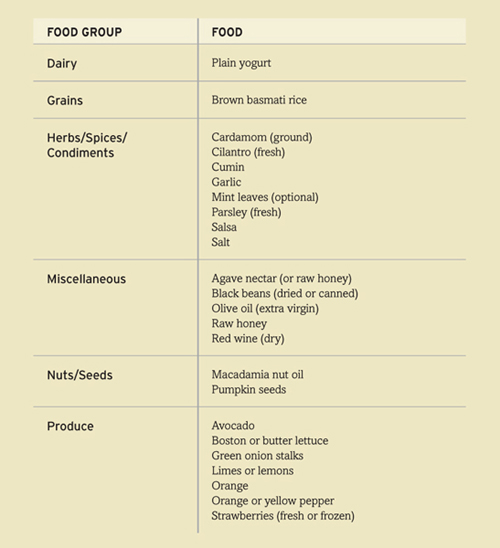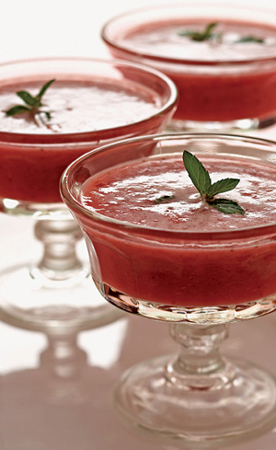

Strawberry Soup
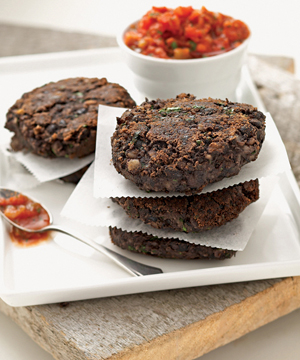
Black Bean Cakes
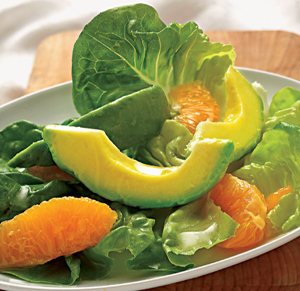
Citrus Avocado Salad with Nut Oil
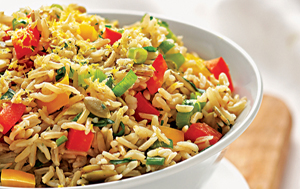
Confetti Basmati Rice
38 Citrus Avocado Salad with Nut Oil
THIS MEAL is a vegetarian delight that even a meat lover could love. The grains/beans/seeds combo provides quality vegetarian protein, meaning it contains all of the essential amino acids (always a challenge for vegetarians). The meal is low glycemic (more on that in a moment), loaded with healthy fats, and high in fiber. And the dessert is as delicious as it sounds. What could be bad?
The centerpiece of the entrée is black beans in the delicious Black Bean Cakes. I’ve written extensively—in The 150 Healthiest Foods on Earth and countless articles—about the importance of keeping blood sugar smack in the middle of what my friend Barry Sears, M.D., calls “The Zone.” Remember Goldilocks tasting her porridge? (“Not too hot, not too cold … just right.”) Well that’s how you want your blood sugar. If you drew a picture of how your blood sugar fluctuates during the day, you’d want it to look like a nice rolling lake in the summer, not like a tidal wave in the Pacific. Most people eating the standard American diet would have a blood sugar “graph” that looked like the latter, not the former.
I’m fond of saying that when you eat a bagel (or any food that contains a lot of sugar or converts to sugar quickly) your blood sugar skyrockets to the ceiling (think “tidal wave”). Beans are the ultimate “low glycemic” food, meaning their effect on your blood sugar is slow, gradual, and gentle (think “rolling lake”).
Why is this important? Because high levels of blood sugar produce high levels of insulin, the fat-storing hormone. And because what goes up must come down, high levels of blood sugar also generally result in a big old crash, leaving you with cravings, hunger, and a ravenous desire for more carbohydrates, which will push your blood sugar back up, starting the whole cycle over again. Meanwhile, you rarely feel good, your energy and mood suffer, you’re not a lot of fun to be around, and it’s fiendishly difficult to lose weight.
Sound familiar?
• The beans and rice have extended cooking times, so begin with these items. Set both to soak in the morning or overnight and start the meal preparation with the beans.
• When beans are on the stove, prepare the rice.
• The salad and dessert can be assembled while the beans and rice are cooking, or you can prepare the dessert soup after you eat because the prep time is minimal.
THE NUMBER ONE WEIGHT-LOSS SUPPLEMENT
The reason beans are such a great low glycemic food can be summed up in one word: fiber. When I wrote Living the Low Carb Life, I included a chapter on weight-loss supplements in which I said that almost none of them did any good (I’ve since amended that—see The Most Effective Natural Cures on Earth). What I’d now say is that very few of them do any good. The exception is what I call the number one supplement for weight loss—fiber.
Fiber’s not expensive, it’s not sexy, and it’s not exotic, but it works like a charm, and beans are one of the best sources on the planet. There are at least a dozen clinical studies that have linked fiber with weight loss. Fiber makes you feel full and therefore less likely to overeat. It suppresses hunger. It enhances blood-sugar control and insulin effects and—according to the CRC Handbook of Dietary Fiber in Human Nutrition, fiber can even reduce the number of calories that the body absorbs—translating into a 3- to 18-pounds of weight loss per year by some estimates! Fiber rocks! And beans have got it.
BEANS’ CELL-PROTECTING BENEFITS
Besides fiber, there are other compounds in beans that protect your health. One phytochemical in beans—called dysgenic—seems to inhibit cancer cells. Other phytochemicals—such as saponins, protease inhibitors, and physic acid—seem to protect cells from the kind of genetic damage that can lead to cancer later on. Saponins, for example, seem to inhibit the reproduction of cancer cells and also slow the growth of tumors. While all this lab stuff is interesting, more important is the simple fact that folks who eat beans have a reduced rate of cancer. An analysis of questionnaires in the famous Nurses’ Health Study all found that women who consumed higher intakes of beans (or lentils) had a striking 24 percent reduced risk of breast cancer, and all that seemed to be needed was a minimum of two servings per week. And according to the American Institute of Cancer Research, men who eat the most beans have a 38 percent lower risk of prostate cancer than men who eat the least. Worth thinking about.
A PRODUCE BONANZA
The Citrus Avocado Salad with Nut Oil salad is built around one of my favorite foods—avocado. The poor avocado suffered from an undeserved bad reputation for so many years while the country was in the grips of the mass dietary hysteria that produced the low-fat movement, but thankfully we’re coming to our senses and recognizing the overwhelming benefit of certain kinds of fat in our diet.
One of those healthful fats is monounsaturated fat—and avocado is loaded with it. Monounsaturated fat like the kind found in avocados is a big part of one of the healthiest diets in the world—the Mediterranean diet. Virtually every study has shown that people eating a Mediterranean diet—with its emphasis on fish, fruits, vegetables, nuts, and monounsaturated fat—have lower rates of heart disease. People following a modified low carb diet high in monounsaturated fat lost more weight than people following the standard National Cholesterol Education Program diet, according to research published in 2004 in the Archives of Internal Medicine. I’ve been known to eat half an avocado right out of the shell, just for a mini-meal. Delicious? Yes. Fattening? No. At least if you eat it instead of an equal number of calories of junk food.
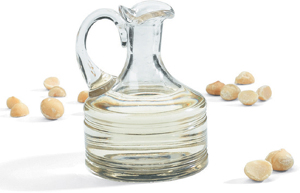
The Confetti Basmati Rice contains a colorful mixture of red and yellow peppers (an excellent source of vitamins C and A), green onion, and parsley (or cilantro), plus toasted pumpkin seeds. These delicious seeds pack a nutritional wallop. They are a rich source of minerals, especially magnesium, potassium, and phosphorus. Interestingly, the roasted kind has far more protein, at least according to the U.S. Food and Drug Administration’s food database. Read more about the benefits of rice in Chapter 11.
A SWEET DESSERT
The Strawberry Soup dessert is outstanding, and since the overall glycemic load of the meal is low, it’s not likely to do much damage to your blood sugar. Yogurt—featured in the soup—is loaded with probotics, the beneficial bacteria that help keep your gut healthy and your digestive processes running smoothly. And another soup ingredient, raw honey, unlike that imposter that comes in the cute little squeezy bear, is a real food. It hasn’t been heated, so the enzymes are intact, and it tastes way better than the homogenized, pasteurized imitators.
Enjoy!
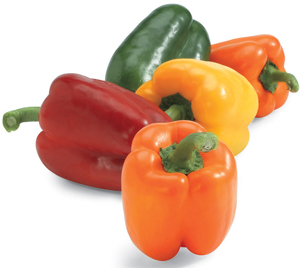
Beans are really good for you, but they may not make you the most popular houseguest. In fact, they could easily put a major damper on your social life.
Let’s face it, some people just stay away from beans because digesting them—at least without certain embarrassing side effects—is difficult. But here’s the thing—your system may simply need time to adjust to them, especially if they are a relatively new food in your diet or you eat them infrequently. You can minimize the digestive issues by adding beans to your weekly diet slowly. Some experts feel that by increasing the amount of beans you eat gradually, your system will get better at both producing “bean-breaking” enzymes and digesting beans.
Also, presoak and cook beans thoroughly: they must be tender to the squeeze. Undercooked beans are particularly hard to digest. Chewing them slowly and thoroughly will also help. Drink plenty of water between meals.
And don’t forget Beano. Just as Lactaid helps you break down the lactose milk sugar in milk that causes problems for many people, Beano helps break down two of the sugars most responsible for forming gas—stachyrose and raffinose. Beano is basically a great natural over-the-counter enzyme product that can really help reduce gas.
Fiber-rich comfort food
Prep Time: 10 minutes
Cook Time: Soak overnight, approximately 70 minutes cooking time and 60 minutes refrigeration time
Ingredients
2 cups (1 lb, or 500g) dried black beans, picked over and rinsed, soaked overnight and drained
½ teaspoon cumin
4 cups (940 ml) water or broth (one 32-oz carton, organic, no-sodium-added, vegetable or chicken broth)
8 medium cloves garlic, finely minced
½ cup (8 g) fresh cilantro, chopped
½ teaspoon salt
1 to 2 tablespoons (15-30 ml) extra virgin olive oil
1 cup (520 g) salsa, any variety, optional
Combine the black beans, cumin, and water or broth in a large saucepan over high heat. Bring to a boil. Reduce heat to low, partially cover, and simmer until beans are tender (60 to 70 minutes). Drain well.
In a large bowl, mash the beans and garlic together well. Stir in the cilantro and salt. Form the mixture into eight cakes. Transfer to a plate and refrigerate for one hour.
In a large, nonstick frying pan, heat the olive oil over medium heat. Add the cakes and cook, turning over once, until warmed and the outside is slightly crisp, about 5 to 7 minutes. Serve immediately with salsa on the side. Leftovers keep well for 2 to 3 days.
Yield: 8 servings
• If you don’t have time to cook beans from scratch, use 5 cups canned organic beans, rinsed and drained.
• To remove the lingering smell of garlic or onion from your hands, rinse with a stainless steel “soap” bar and water. A steel soap bar is a piece of stainless steel in the shape of a soap bar. Holding the bar under running water and rubbing your hands and fingertips along its surface helps to more efficiently remove the lingering odors of strong foods like garlic and onions. The shape itself isn’t important—any piece of stainless steel will accomplish the same thing. You can purchase a steel soap at most kitchen goods supply stores for $5 to $10.
• A garlic press is a handy tool for quickly mincing lots of cloves. If you don’t have one, try putting an unpeeled clove under a vegetable scraper and leaning down on it with the flat of your hand to crush it. The meat will come easily out the skin and you can mince further with a sharp knife, if necessary.
• Use non-Teflon, nonstick pans for reduced oil sautéing or healthy “frying.”
Canned versus Dried Beans
• Cooking your own beans is cheaper than buying canned beans. Home-cooked beans taste fresher, plus no vitamins, minerals, or enzymes are destroyed by pre-cooking or canning.
• For busy individuals or families, canned beans are still a great option. But read the labels: choose beans that are organic and free of added salt, msg, or preservatives.

A vitamin and mineral packed side dish
Prep Time: 10 minutes
Cook Time: 1 hour
Ingredients
1 cup (195 g) brown basmati rice, well rinsed (and soaked, optional)
¼ cup (35 g) raw or toasted pumpkin seeds
2 cups (470 ml) water or broth (no-sodium-added vegetable or chicken broth)
Pinch salt
½ red pepper, diced into squares (see Notes from the Kitchen)
½ yellow or orange pepper, diced into squares (see Notes from the Kitchen)
¼ cup (4 g) flat leaf parsley or cilantro, washed and coarsely chopped
1 bunch green onion stalks, diced into ½ inch pieces, bulbs removed
Zest from half a lime or lemon
2 tablespoons (30 ml) fresh squeezed lime (about 1 lime) or lemon juice (about half a lemon)
Add the rice, seeds, water or broth, and salt to a medium saucepan with a tight-fitting lid. (You can also use same proportions in a rice cooker, set for brown rice.) Bring to a boil and stir once. Reduce the heat to low, cover, and simmer for about 50 minutes. Remove from heat without removing lid. Allow to sit covered for 10 minutes.
While the rice is resting, core and seed the peppers. Dice them into small, ½-inch squares. Clean and chop the cilantro and green onion stalks. Zest the lemon or lime, cut it, and squeeze the juice. Fold all ingredients gently into the rice until well-combined.
Serve immediately. Leftovers keep well for 2 to 3 days.
Yield: 8 servings (about 3 cups [675 g] in total)
• Basmati is an aromatic rice with a dry grain that tends to stay separate rather than clump together. You must rinse it gently but thoroughly until the rinse water does not cloud.
• Store grains in the fridge if you have room, or freeze for three days in the freezer to kill meal moth eggs and then store in cool, dark pantry.
• Cutting pepper “confetti”: Choose square-shaped peppers. Cut off the tops and bottoms and cut down one side on a “corner edge” to open the peppers. Neatly pull out the core and seeds. Cut the peppers into four square, flat pieces. Cut into ½-inch strips, then dice strips into ½-inch squares, removing any remaining white stalk.
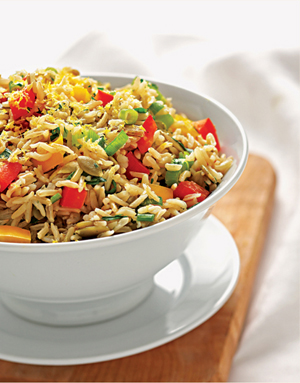
Rich in good fat and vitamin C
Prep Time: 5 to 10 minutes
Cook Time: None
Ingredients
1 ripe avocado, sliced into eighths
1 orange (blood orange, if available), peeled, cut in half, segments pulled apart
1 head Boston or butter lettuce, washed, cored, and leaves separated
1 tablespoon (15 ml) macadamia nut oil
1 teaspoon agave nectar or ½ teaspoon raw honey
1 tablespoon (15 ml) fresh lime juice (½ lime squeezed well)
Lay out whole lettuce leaves to cover the surface of a platter. Arrange avocado slices on top of leaves. Fill in with orange segments. Whisk oil, sweetener, and lime juice together well. Drizzle dressing over top of salad. Serve immediately.
Yield: 4 generous servings
• Speed the ripening process by placing the avocado in a brown paper bag with a banana or an apple. You can also wrap it in a warm towel and put it in the sun. Fruit ripens best in a warm, dark place.
• If you want to make a smaller salad and save half of the avocado, leave the pit in remaining half—it will help slow the browning process.
• To cut an avocado cleanly, insert a sharp knife along the length of the fruit and turn the fruit to make a neat, lengthwise cut through the middle. Twist the two halves apart and lay them down. Insert the tip of your knife or a sharp fork into the pit (while on the counter, not in your hand!) and, grasping the meat gently, twist the pit out of the avocado.
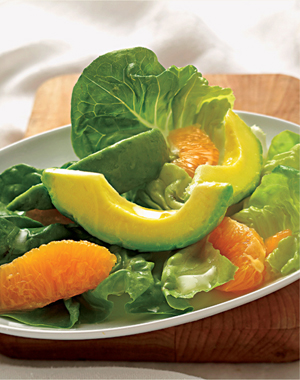
Fortified with probiotic-rich yogurt
Ingredients
Prep Time: 5 to 10 minutes
Cook Time: None
2 heaping cups (290 g) strawberries, washed and stemmed (1 pint of fresh is best, or 2 cups frozen, thawed)
1½ cups (355 ml) cold water
¼ cup (60 ml) dry red wine, such as Merlot
¼ cup (85 g) raw honey
½ cup (115 g) plain yogurt
¼ teaspoon ground cardamom
Sliced berries or mint leaves for garnish, optional
Fill a 2-cup liquid measuring cup to overflowing with the strawberries. Rinse the berries, drain, and pour into a blender. Measure the cold water and wine into a measuring cup and add four ice cubes to chill further.
Puree the berries. Add the honey and yogurt and blend lightly until well mixed. Pour the strawberry mixture into a bowl. Gently stir in the water/wine mixture, straining through and discarding ice cubes. Stir in cardamom.
Serve very cold, garnished with a few sliced berries or mint leaves.
Yield: 6 servings
• You can use other berries, such as blueberries or raspberries, for an equally delicious soup. Simply adjust the sweetener amounts to taste. A dry fruity white wine, such as a Chardonnay, Sauvignon Blanc, or a good Chablis, works well.
• Raw berry soups are the perfect finisher for pungent spicy dishes or hot summer nights.
Making Mexican Meals Healthier
Here are ways to increase the health benefits of Mexican food.
• Don’t fry refried beans: boil and mash them instead, adding spices for flavor.
• Salsas are a great way to add fresh vegetables and fruits to a meal while sparking up its color and taste. So don’t be afraid to experiment with different types.
• Avoid the starchy Spanish rice and choose a brown rice, or better yet, double up on the vegetables.
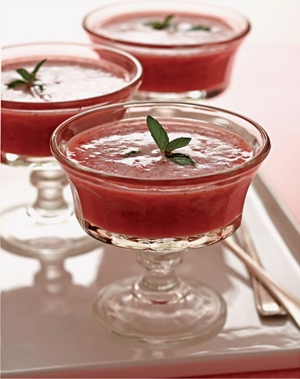
The Environmental Working Group, a nonprofit research organization based in Washington, D.C., analyzed the results of nearly 43,000 Department of Agriculture and Food and Drug Administration tests for pesticides on produce conducted between 2000 and 2004.
The group found that the peaches and apples topped the list of most contaminated, with almost 97 percent of peaches testing positive for pesticides and almost 87 percent having two or more pesticide residues. Approximately 92 percent of apples tested positive, with 72 percent having two or more residues.
The following twelve fruits and vegetables were the most contaminated, the group found:
1. Peaches
2. Apples
3. Sweet bell peppers
4. Celery
5. Nectarines
6. Strawberries
7. Cherries
8. Pears
9. Imported grapes
10. Spinach
11. Lettuce
12. Potatoes
For these twelve foods, as well as with coffee, milk, poultry, and other meat, we recommend that you buy organic.
The counterpart to the Environmental Working Group’s “Dirty Dozen” is their list of the twelve foods that are most consistently clean. Here they are:
1. Onions
2. Avocados
3. Sweet corn
4. Pineapples
5. Mango
6. Asparagus
7. Sweet peas
8. Kiwi
9. Bananas
10. Cabbage
11. Broccoli
12. Papaya
Of the three top foods on the “consistently clean” list—onions, avocados, and sweet corn—more than 90 percent of samples tested had no detectable pesticide residues!
